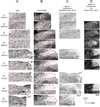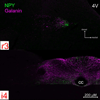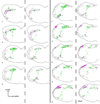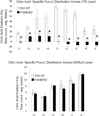Immunocytochemical organization and sour taste activation in the rostral nucleus of the solitary tract of mice
- PMID: 27292295
- PMCID: PMC5138149
- DOI: 10.1002/cne.24059
Immunocytochemical organization and sour taste activation in the rostral nucleus of the solitary tract of mice
Abstract
Sensory inputs from the oropharynx terminate in both the trigeminal brainstem complex and the rostral part of the nucleus of the solitary tract (nTS). Taste information is conveyed via the facial and glossopharyngeal nerves, while general mucosal innervation is carried by the trigeminal and glossopharyngeal nerves. In contrast, the caudal nTS receives general visceral information largely from the vagus nerve. Although the caudal nTS shows clear morphological and molecularly delimited subdivisions, the rostral part does not. Thus, linking taste-induced patterns of activity to morphological subdivisions in the nTS is challenging. To test whether molecularly defined features of the rostral nTS correlate with patterns of taste-induced activity, we combined immunohistochemistry for markers of various visceral afferent and efferent systems with c-Fos-based activity maps generated by stimulation with a sour tastant, 30 mM citric acid. We further dissociated taste-related activity from activity arising from acid-sensitive general mucosal innervation by comparing acid-evoked c-Fos in wild-type and "taste blind" P2X2 /P2X3 double knockout (P2X-dbl KO) mice. In wild-type mice, citric acid stimulation evoked significant c-Fos activation in the central part of the rostral nTS-activity that was largely absent in the P2X-dbl KO mice. P2X-dbl KO mice, like wild-type mice, did exhibit acid-induced c-Fos activity in the dorsomedial trigeminal brainstem nucleus situated laterally adjacent to the rostral nTS. This dorsomedial nucleus also showed substantial innervation by trigeminal nerve fibers immunoreactive for calcitonin gene-related peptide (CGRP), a marker for polymodal nociceptors, suggesting that trigeminal general mucosal innervation carries information about acids in the oral cavity. J. Comp. Neurol. 525:271-290, 2017. © 2016 Wiley Periodicals, Inc.
Keywords: CGRP; RRID: AB_2040054; RRID: AB_2314042; RRID: AB_518147; RRID: AB_518351; RRID: AB_572253; acid; c-Fos; chemesthesis; esophagus; oropharynx; trigeminal.
© 2016 Wiley Periodicals, Inc.
Figures













Similar articles
-
5-HT3A -driven green fluorescent protein delineates gustatory fibers innervating sour-responsive taste cells: A labeled line for sour taste?J Comp Neurol. 2017 Jul 1;525(10):2358-2375. doi: 10.1002/cne.24209. Epub 2017 Apr 21. J Comp Neurol. 2017. PMID: 28316078 Free PMC article.
-
Genetic Deletion of TrpV1 and TrpA1 Does Not Alter Avoidance of or Patterns of Brainstem Activation to Citric Acid in Mice.Chem Senses. 2020 Oct 9;45(7):573-579. doi: 10.1093/chemse/bjaa043. Chem Senses. 2020. PMID: 32572463 Free PMC article.
-
Neurons with diverse phenotypes project from the caudal to the rostral nucleus of the solitary tract.J Comp Neurol. 2018 Oct 1;526(14):2319-2338. doi: 10.1002/cne.24501. Epub 2018 Oct 16. J Comp Neurol. 2018. PMID: 30325514 Free PMC article.
-
Cajal's prophetic functional considerations on respiratory reflexes: new questions about old answers.Prog Brain Res. 2002;136:435-42. doi: 10.1016/s0079-6123(02)36036-9. Prog Brain Res. 2002. PMID: 12143400 Review.
-
Epilepsy, electroacupuncture and the nucleus of the solitary tract.Acupunct Med. 2006 Dec;24(4):164-8. doi: 10.1136/aim.24.4.164. Acupunct Med. 2006. PMID: 17264834 Review.
Cited by
-
Environmental Enrichment Induces Changes in Long-Term Memory for Social Transmission of Food Preference in Aged Mice through a Mechanism Associated with Epigenetic Processes.Neural Plast. 2018 Jul 16;2018:3725087. doi: 10.1155/2018/3725087. eCollection 2018. Neural Plast. 2018. PMID: 30123245 Free PMC article.
-
Taste Impairments in a Parkinson's Disease Model Featuring Intranasal Rotenone Administration in Mice.J Parkinsons Dis. 2022;12(6):1863-1880. doi: 10.3233/JPD-223273. J Parkinsons Dis. 2022. PMID: 35848036 Free PMC article.
-
Mechanisms for the Sour Taste.Handb Exp Pharmacol. 2022;275:229-245. doi: 10.1007/164_2021_476. Handb Exp Pharmacol. 2022. PMID: 34117536
-
A subset of broadly responsive Type III taste cells contribute to the detection of bitter, sweet and umami stimuli.PLoS Genet. 2020 Aug 13;16(8):e1008925. doi: 10.1371/journal.pgen.1008925. eCollection 2020 Aug. PLoS Genet. 2020. PMID: 32790785 Free PMC article.
-
Adjustment of Whey:Casein Ratio from 20:80 to 60:40 in Milk Formulation Affects Food Intake and Brainstem and Hypothalamic Neuronal Activation and Gene Expression in Laboratory Mice.Foods. 2021 Mar 19;10(3):658. doi: 10.3390/foods10030658. Foods. 2021. PMID: 33808819 Free PMC article.
References
-
- Altschuler SM, Bao XM, Bieger D, Hopkins DA, Miselis RR. Viscerotopic representation of the upper alimentary tract in the rat: sensory ganglia and nuclei of the solitary and spinal trigeminal tracts. J Comp Neurol. 1989;283(2):248–268. - PubMed
-
- Archer S, Li TT, Evans AT, Britland ST, Morgan H. Cell reactions to dielectrophoretic manipulation. Biochem Biophys Res Commun. 1999;257(3):687–698. - PubMed
-
- Astrom KE. On the central course of afferent fibers in the trigeminal, facial, glossopharyngeal, and vagal nerves and their nuclei in the mouse. Acta physiol. scand., Suppl. 1953;29:209–320.
-
- Bae YC, Oh JM, Hwang SJ, Shigenaga Y, Valtschanoff JG. Expression of vanilloid receptor TRPV1 in the rat trigeminal sensory nuclei. J Comp Neurol. 2004;478(1):62–71. - PubMed
Publication types
MeSH terms
Grants and funding
LinkOut - more resources
Full Text Sources
Other Literature Sources
Medical
Molecular Biology Databases
Research Materials
Miscellaneous

